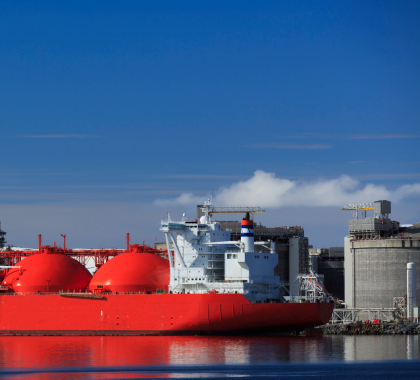With severe winter weather increasing demand for electricity and home heating in the northeastern United States from late December through February, regional utilities used more expensive fuel oil and even imported liquefied national gas (LNG) from Russia to generate electricity and heat homes.
Utilities used Russian gas instead of cheaper, domestically produced natural gas because state governments in the Northeast have blocked various efforts to expand natural gas pipelines in the region, and federal rules, primarily the Jones Act, make transporting domestic American commodities and energy on ships more difficult and expensive.
Plentiful Domestic Supply
The United States is the largest natural gas producer in the world. Most U.S. natural gas is consumed domestically.
February 2018 brought the first export of LNG from Dominion Energy’s Cove Point terminal on the Maryland coast. Cove Point is only the second U.S. LNG export terminal. Cheniere Energy’s Sabine Pass Terminal on the Gulf of Mexico has been exporting LNG for about two years.
Several other export terminals are planned or under construction. The United States is expected to become the top LNG-producing country by 2022, according to the Energy Information Administration, with all U.S.-produced LNG being exported to foreign markets.
In February, Boston, Massachusetts received LNG imports from the $27 billion Yamal Peninsula project, a massive new LNG complex in northern Siberia.
Jones Act Impediment
A central reason ships in the Atlantic carrying U.S. LNG exports from Maryland might pass ships importing LNG from Russia to New England is a 1920 national maritime law, the Jones Act.
The Jones Act became law shortly after the end of World War I. The main reason Congress gave for passing the Jones Act was to ensure the United States had a functioning merchant fleet and operating shipyards ready in times of war. The law requires all goods transported by water between U.S. ports be carried on U.S.-flagged ships constructed in the United States, owned by U.S. citizens, and crewed by U.S. citizens or U.S. permanent residents.
This law was adopted decades before the development of the huge, ball-shaped tanker ships in which LNG is carried. Despite the Jones Act, no vessels designed to carry LNG have been built in the United States. As a result, LNG exports from U.S. ports are transported on foreign-built, foreign-flagged vessels, which are precluded by the law from delivering their loads to ports in the United States.
‘Antiquated’ Law
David G. Tuerck, Ph.D., a professor of economics at Suffolk University, says the Jones Act is outdated and bad for the U.S. economy.
“The Jones Act is as antiquated a piece of legislation as one can imagine,” said Tuerck. “By limiting merchant shipping between U.S. ports to U.S. vessels, it drives up shipping costs, particularly for U.S. ports outside the lower 48 states.”
Alaska, Hawaii, Puerto Rico
Businesses and consumers in Alaska, Hawaii, and the Commonwealth of Puerto Rico, a U.S. territory, are hit particularly hard because those states depend on ships to supply most of their goods.
Keli’i Akina, Ph.D., president of the Grassroot Institute of Hawaii, says the Jones Act increases consumer energy prices nationwide.
“This outmoded federal law prevents shipping LNG from one U.S. port to another, because there aren’t any Jones Act-compliant U.S. vessels that can carry LNG,” Akina said. “Alaska, Hawaii, and Puerto Rico are especially hard-hit by the Jones Act.
“But as the recent winter in the northeastern United States shows, even consumers in the continental United States can be harmed by the Jones Act,” said Akina. “The Jones Act makes it virtually impossible to send domestic LNG supplies from one port in the United States to another.”
National Security ‘Hindrance’
In addition to raising prices for consumers, the Jones Act may also be damaging national security, Akina says.
“Could there be a stronger argument to modernize the Jones Act than international companies exploiting it to bring Russian LNG to the United States, violating the spirit, if not the letter, of U.S. sanctions on Russian businesses?” Akina said. “Despite the fact America produces sufficient LNG to fill the need that prompted the Russian shipment, we couldn’t bring the gas from one part of the country to another because of a law supposedly intended to bolster our national security.
“The fact that U.S. LNG exporters are unable to ship their supplies from one port within the United States to another provides a strong argument the Jones Act is a hindrance to our national security,” Akina said.
State Government Obstacles
The least expensive and safest way to transport natural gas within the United States is by pipeline, and as a result, pipelines are commonly used to ship the fuel throughout most of the country. There is a shortage of natural gas pipelines across the northeastern United States, a region that has lagged behind much of the country in using natural gas to generate electricity.
Although the Marcellus and Utica shale formations in New York, Ohio, Pennsylvania, and West Virginia could provide all the natural gas the northeastern states require, Maryland, New York, and Vermont have banned fracking to produce natural gas within their borders, and other states have erected regulatory barriers to the activity. In addition, opposition by several governors and environmental agencies in New York and other states in the region has resulted in the cancellation of two pipeline projects in the northeast since 2015.
Joe Barnett ([email protected]) writes from Dallas, Texas.





